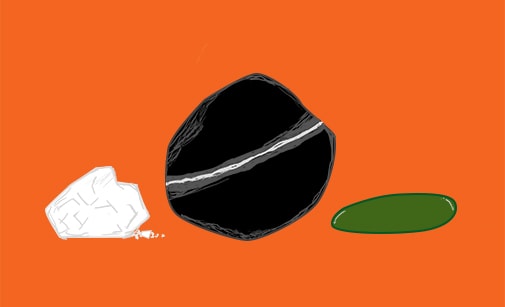Grade Level
All
minutes
15 minutes or fewer
subject
Earth Science
Activity Type:
Science Club, geology, Rocks, After School Activity
For this Science Club, we celebrated rocks by making a #neatrock collection—a big one—and we did it with your help!
We asked you to:
-
Find a really neat rock.
-
Share a photo of your rock and tell us why you think it’s neat with the hashtag #neatrock.
Rocks are neat.
Well, actually, rocks are really really neat. Rocks can have wild features on their surface or hide beautiful crystals inside. Rocks might be formed around extinct animals or inside of volcanoes or in distant galaxies. They might have been smoothed by streams or cracked by ice or polished by our atmosphere. A rock could be as old as our planet, or it could have been born yesterday in a science class, beneath a fire on a beach, or in a factory. Even the diversity of rock sizes and shapes might surprise you—rocks can be microscopic, as thin as paper, or as large as a mountain.

Keep reading to see the #neatrock collection of over 900 rocks submitted by SciClub participants, learn more about Earth Science Week, and read our FAQ
This Is Plastiglomerate
#NeatRock FAQ
What if I don’t know much about rocks?
In collaboration with the American Geosciences Institute, we’ve got loads of tips and tools to support you in your exploration of neat rocks:
- Start by checking out this great list of rock inquiry resources, including rock identification guides, geologic maps, and national organizations dedicated to earth science education.
- If you want to learn about your local rocks from an expert in your region, you can find an earth science organization near you with this handy Earth Science Organization Finder or explore this fully interactive USGS geologic map.
- If you just want to experience really neat rocks in a really neat setting, try clicking through this amazing virtual 360-degree geologic expedition.
- If you submitted rocks in October 2017, our team of geoscience experts are working to respond to your submissions with fun facts and information. We’ll be doing our best to answer your questions and direct you to more information, thanks for your patience!
How do I find a #neatrock?
You can find neat rocks anywhere, even on your roof! Be careful when looking for neat rocks that you don’t remove them from protected areas or private property, and try to leave nature the way you found it. Please be safe and lawful in your pursuit of neat rocks (for Science Club rules of the road, please read our project policies page).
Why neat rocks?
We were thrilled to launch this challenge as part of Earth Science Week, an international celebration of earth sciences and earth stewardship. You can learn more about Earth Science Week here. Also, is there ever a bad time to celebrate rocks? Nope, didn’t think so!
Who can participate and how can I submit my #neatrock?
Anyone, anywhere can participate by sharing a photo, illustration, or description of a neat rock they’ve found and why they think it’s neat. Please do not mail us real physical rocks! You can post your rock photo and observations to Twitter or Instagram with the hashtag #neatrock. If you’re under the age of 13, please have a parent help you submit your #neatrock.
I’m a teacher, how can I help my students participate?
If a student brings you a mystery rock, what do you do? We asked a panel of experienced geoscience educators to share their ideas in an interactive training on rock observation and inquiry. You can view the recorded Rock Inquiry 101 webinar, check out the slide deck, or download this list of rock inquiry resources to get started. For more ideas and earth science teaching resources, check out AGI’s Education Resource Network.
Educator's Toolbox
Meet the Writer
About Ariel Zych
@arieloquentAriel Zych is Science Friday’s director of audience. She is a former teacher and scientist who spends her free time making food, watching arthropods, and being outside.
4 thoughts on “SciFri Science Club: #NeatRock Challenge”
Comments are closed.



Just rocks, or are minerals okay too?
Minerals are totally in-bounds, nay, they are welcome!
shapes might surprise you—rocks can be microscopic, as thin as paper, or as large as a mountain.
tweets were good.